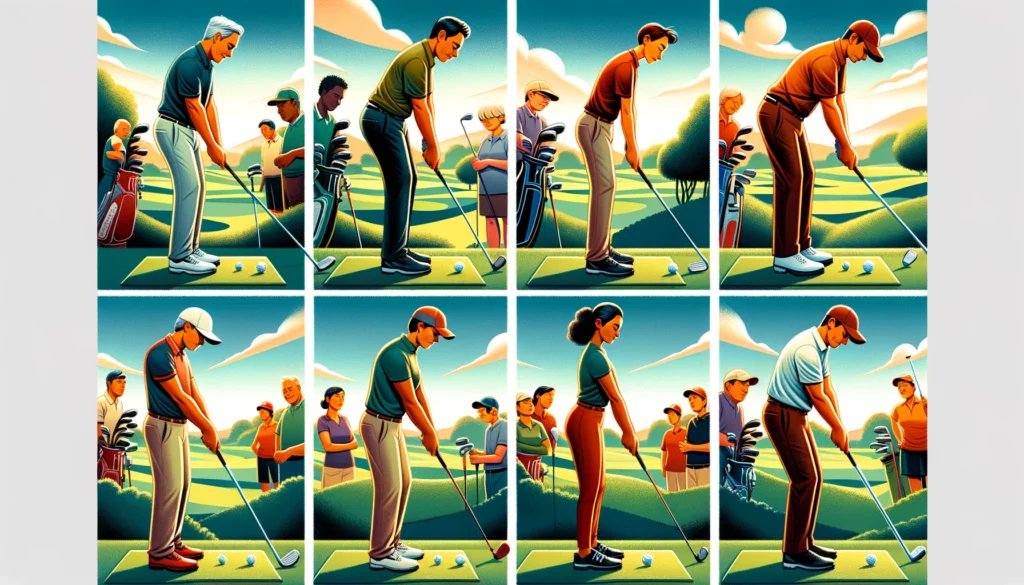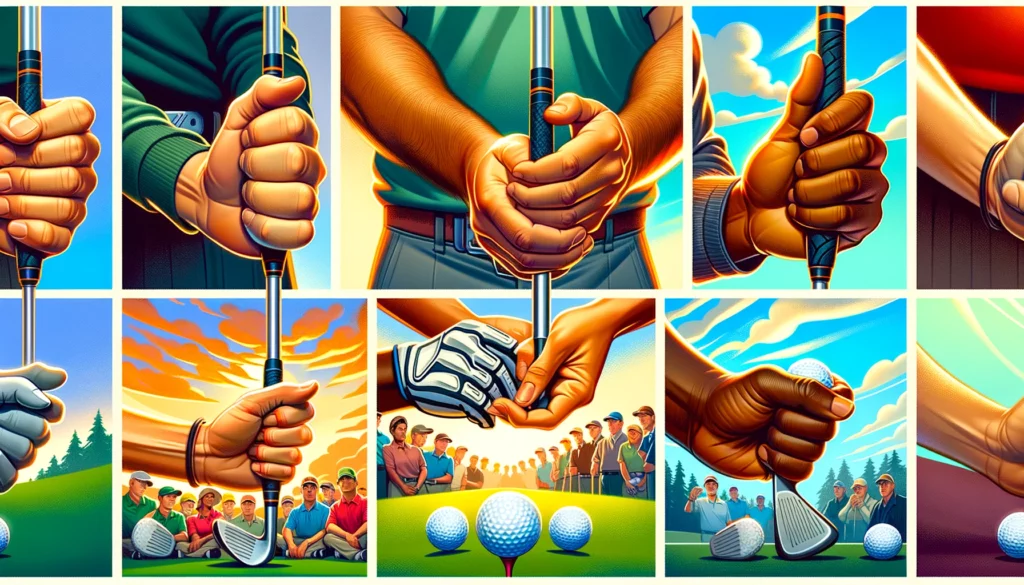Welcome to the confluence of skill and precision, where the humble yet pivotal element of your golf game – the golf grip – takes center stage.
Whether you’re a seasoned golfer or new to the fairways, understanding how to grip a golf club is the keystone to a successful swing. From the perfect golf grip to the nuanced application of grip pressure, we’re embarking on a detailed exploration that caters to right-handed golfers, left-handers, and everyone in between.
The Basics of a Proper Golf Grip
Every golfer’s journey toward mastery begins with the fundamentals, and a proper golf grip is the starting point.
It’s the only connection you have with your golf club, making it a critical aspect to perfect. Let’s delve into the core principles that define a great grip and how it can be the secret to that satisfying sound of the perfect shot.
We’ll break down the anatomy of the grip, from the left thumb to the right pinky finger, ensuring that each digit has its rightful place on the club’s handle.
Grip Fundamentals: How to grip a golf club
The path to a consistent golf grip begins with the placement of your left hand (for right-handed golfers). The left thumb should rest snugly along the shaft, creating a firm foundation.
The middle fingers play a subtle yet significant role in securing the handle, while the right hand complements this by wrapping around in a supportive, yet unrestrictive manner.
The right grip pressure – akin to holding a bird without letting it fly away or squeezing too tight – is essential. We’ll dive deep into how the pressure of your middle finger and other nuances can make or break your swing.

Golf Grip Variations
Venturing further into the realm of golf grips, we explore the interlocking grip, favored by players who seek a locked-in feel, and the overlapping grip, which is the hallmark of many seasoned golfers.
Each grip style has its merits, and we’ll guide you through finding one that feels natural and enhances your entire swing. Whether you’re contemplating a neutral grip or a stronger hold, understanding the different grip styles, including the baseball grip, can significantly influence your game.
Overlapping Grip (Vardon Grip)
This grip promotes unity between the hands, encouraging them to work together during the swing. It’s suitable for golfers with larger hands and those looking for a stable yet relaxed feel.
Interlocking Grip
Ideal for players with smaller hands, this grip ensures a secure connection between the hands and the club. It can enhance wrist movement and is beneficial for those who need extra clubface control.
Baseball Grip (Ten-Finger Grip)
This grip is user-friendly, especially for beginners or those with joint pain, as it can feel more natural and reduce strain on the hands.
Neutral Grip
The neutral grip is recommended for most golfers because it tends to produce the most consistent shots, allowing for a square clubface at impact.
Strong Grip
This grip is turned away from the target and is often used by players who tend to slice the ball as it helps to close the clubface more easily at impact.
Weak Grip
Rotated towards the target, this grip can help players who struggle with hooking the ball, as it tends to keep the clubface open at impact.
Cross-Handed Grip (Lead Hand Low)
Commonly used for putting, this grip can improve stroke stability and is often used by players looking to reduce wrist action in their putting stroke.
Split-Hand Grip
This unconventional grip is sometimes used for training purposes to teach the hands to work independently or to correct certain swing path issues.
Claw Grip
Often adopted in putting to help keep the wrist firmer through the stroke, this grip is chosen by players who want to minimize hand action on the greens.
Palm Grip
Used mainly for putting, this grip allows for a firmer wrist position and can provide a more stable stroke, often preferred by golfers struggling with wristiness in their putts.
Reverse Overlap
This is a traditional putting grip that offers a stable hand position for a smooth, consistent putting stroke.
Vardon Overlap
Same as the Overlapping Grip, this grip is named after Harry Vardon who popularized it, and it’s used for its blend of control and comfort.
Double Overlap
With two fingers overlapping, this grip can provide extra control for golfers with very large hands or those seeking a very unified hand action.
Pressure Grip
Adjusting grip pressure is crucial for shot-making. A softer grip can enhance feel, while a firmer grip can provide more control in windy conditions or rough.
Prayer Grip
For putting, it helps keep the hands level and the putter face square, useful for those with a tendency to twist the putter during the stroke.
Saw Grip
This putting grip can enhance feel and provide a cleaner stroke, often adopted by players seeking a change to improve their putting consistency.
Left-Hand Low
For right-handed golfers, this grip can promote a more even shoulder alignment and a smoother putting stroke, often used by players looking to combat a pull.
Arm Lock Grip
Pressing the putter against the forearm provides stability, particularly useful for those who struggle with wrist movement during their putting stroke.
Pistol Grip
The putter grip is shaped to fit the hand more ergonomically, which can lead to a more comfortable and controlled putting stroke.
Fingers Down the Shaft
Extending the fingers down the shaft on putts provides greater feel, which can help when judging distances on the green.
One-Handed Grip
While not commonly used in play, practicing with a one-handed grip can improve wrist hinge and hand strength.
Two-Thumbs-Down Grip
This putting grip can lead to a smoother stroke by aligning the thumbs directly down the putter grip, aiding in better roll and distance control.
Long Thumb Grip
The extended thumb can increase leverage and control, which is beneficial for golfers looking to enhance their swing path and maintain a consistent grip pressure.
Short Thumb Grip
With the thumb kept short, golfers can increase the hinge in their wrists, potentially increasing swing speed and aiding those looking to add power to their shots.
(5) How To Grip The Golf Club | 3 Grips – Which Is Right For You? – YouTube
Common Mistakes and How to Correct Them
Even the most experienced golfers can fall prey to common errors like the weak golf grip, which can open the club face and lead to wayward shots.
We’ll examine these missteps, such as an incorrect left thumb placement or an overly tight right grip, that can inadvertently alter the club face angle, impacting your ball flight.
From understanding the importance of a neutral grip to mitigating a grip that’s too strong or too weak, we provide insights into keeping the club face square for that straight ball flight we all aim for.
Advanced Techniques
For those looking to refine their technique, we’ll cover how slight grip adjustments can affect ball flight and how a neutral golf grip can offer the balance needed for various shots.
And for the left hand, we’ll discuss how the index finger’s position can be a game-changer, along with the strategic placement of the right thumb. We’ll also explore how the grip can change with clubs, from the driver to the putter, and the impact it has on your golf swing.
Drills for a Consistent Golf Grip
Practice is paramount when it comes to maintaining a perfect golf grip. We’ll introduce drills designed by PGA golf professionals that you can do at the driving range or even at home, ensuring that your grip becomes second nature.
We’ll cover exercises for both the left hand and the right, focusing on creating muscle memory for a grip that’s both comfortable and effective. These drills will aim to promote a lighter grip pressure, which can lead to a more fluid swing and better ball striking.
Grip It Right and Watch Your Golf Game Transform
As we wrap up, remember that the right grip can elevate your game and bring you closer to the golf scores you dream of.
From the left thumb to the right pinky finger, every detail counts.
So grab your golf club and let’s get gripping! With the right practice, a proper golf grip will become an instinctive part of your golf game, paving the way for a more enjoyable and successful experience on the course.
FAQs
Types of Golf Grip
In golf, the three primary grips are the interlocking, overlapping, and baseball grips. The interlocking grip, where the pinkie finger of the trailing hand interlocks with the index finger of the lead hand, is often used by players with smaller hands or those who need a firmer wrist lock.
The overlapping grip, or Vardon grip, has the trailing hand’s pinkie resting on top of the gap between the index and middle finger of the lead hand and is favored for its relaxed feel. Lastly, the baseball grip has all fingers on the club, similar to holding a baseball bat, and can be easier for beginners due to its simplicity.
Perfect Golf Grip
The perfect golf grip is one that allows for control over the club while maintaining a natural and comfortable hand position. It should enable the golfer to deliver the club face squarely at impact for consistent shots.
The ideal grip balances firmness without tension; the hands must work together as a unit. While there is no one-size-fits-all grip, the best grip for any golfer is one that feels natural, provides stability, and allows for the necessary wrist hinge in the swing.
Professional Golfers’ Grip
Most professional golfers use either the interlocking or overlapping grip. They opt for these grips because they provide a good mix of control and flexibility. Professionals adjust their grip pressure and positions slightly based on the shot they’re playing and their individual swing characteristics.
They ensure their grip promotes a square club face at impact, which is critical for shot accuracy. Observing how professionals grip the club can provide insights, but it’s important for each golfer to develop a grip that suits their own game.

Replacing Your Own Golf Grips
Yes, golfers can replace their own grips. With a few tools like a hook blade, double-sided tape, grip solvent, and a vice to secure the club (though it’s not strictly necessary), the process can be straightforward.
It’s a matter of removing the old grip, cleaning the shaft, applying new tape, wetting it with solvent, and then sliding the new grip on. Many golfers find this a cost-effective and satisfying DIY project.
Cost of New Golf Grips
The cost to put a new grip on a club can vary depending on the type of grips purchased and whether you do it yourself or have it done professionally. Basic grips can be as affordable as a few dollars each, while premium grips can cost $10-$20 or more. If you’re paying for installation, expect to add about $2-$4 per club for labor at most shops.
Common Golf Club Grip
The most common way to grip the golf club is the overlapping grip, especially among male golfers with average or larger hands. It’s often recommended because it helps to unify the hands and create a smoother swing.
This grip is frequently taught to those learning the game and has been used by many of the game’s greats.
Grip for Driver vs. Irons
While some golfers use the same grip for both drivers and irons to maintain consistency, others adjust their grip slightly for different clubs.
For instance, a golfer might use a stronger grip with a driver to promote a draw or a weaker grip with irons to control trajectory. However, most teaching professionals advise recreational golfers to use the same grip for all clubs to simplify the game.







